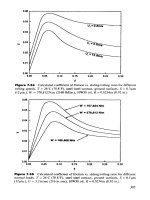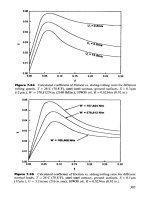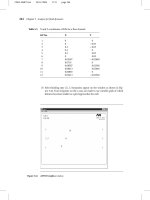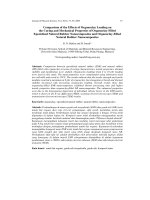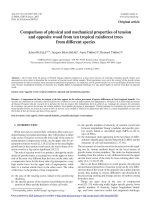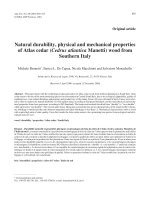Materials Science and Engineering - Electronic and Mechanical Properties of Materials Part 4 pps
Bạn đang xem bản rút gọn của tài liệu. Xem và tải ngay bản đầy đủ của tài liệu tại đây (452.35 KB, 10 trang )
3.225
9
Diffraction Picture of the Origin of Band Gaps
Probability Density=probability/volume of finding electron=|ψ|
2
x
a
x
a
s
a
π
ψ
π
ψ
2
2
2
2
cos4
sin4
=
=
a
a
•
Only two solutions for a diffracted wave
•
Electron density on atoms
•
Electron density off atoms
•
No other solutions possible at this wavelength: no free traveling wave
© E. Fitzgerald-1999
3.225
10
•
Assume electrons with wave vectors (k’s) far from diffraction
condition are still free and look like traveling waves and see
ion potential, U, as a weak background potential
•
Electrons near diffraction condition have only two possible
solutions
–
electron densities between ions, E=E
free
-U
–
electron densities on ions, E= E
free
+U
•
Exact solution using HΨ=EΨ shows that E near diffraction
conditions is also parabolic in k, E~k
2
Nearly-Free Electron Model
© E. Fitzgerald-1999
5
6
3.225
11
Nearly-Free Electron Model (still 1-D crystal)
m
p
m
k
E
22
222
==
h
E
k
∆
k=2
π
/L
Quasi-continuous
k
m
k
E
m
k
dk
dE
∆=∆
=
2
2
h
h
states
π/a-π/a
0
E
g
=2U
Diffraction,
k=n
π
/a
Away from k=n
π
/a,
free electron curve
∆
k=2
π
/a=G=reciprocal lattice vector
Near k=nπ/a,
band gaps form, strong
interaction of e- with
U on ions
© E. Fitzgerald-1999
3.225
12
Electron Wave Functions in Periodic Lattice
• Often called ‘Bloch Electrons’ or ‘Bloch Wavefunctions’
E
k
π/a
0
Away from Bragg condition, ~free electron
m
k
Ee
m
U
m
H
ikx
o
2
; ;
22
22
2
2
2
2
hhh
=≈∇
−
≈+∇
−
=
ψ
Near Bragg condition, ~standing wave electron
() () ()
xUExuGxGxxUU
m
H
ooo
==≈≈+∇
−
=
;sinor cos ;
2
2
2
ψ
h
Since both are solutions to the S.E., general wave is
()
xue
ikx
latticefree
==Ψ
ψψ
termed Bloch functions
© E. Fitzgerald-1999
7
3.225
13
Block Theorem
• If the potential on the lattice is U(r) (and therefore
U(r+R)=U(r)), then the wave solutions to the S.E. are a
plane wave with a periodic part u(r) that has the periodicity
of the lattice
() ()
() ( )
Rruru
ruer
rik
+=
=Ψ
⋅
Note the probability density spatial info is in u(r):
()
)(
*
2
*
ruru
o
⋅Ψ=ΨΨ
An equivalent way of writing the Bloch theorem in terms of Ψ:
(
(
(
(
()
( ()
reRr
e
r
eRrueRr
Rik
rik
RrikRrik
Ψ=+Ψ
Ψ
=+=+Ψ
⋅
⋅
++
© E. Fitzgerald-1999
3.225
14
Reduced-Zone Scheme
• Only show k=+-π/a since all solutions represented there
π/a
−π/a
© E. Fitzgerald-1999
)
)
)
)
)
8
3.225
15
Real Band Structures
• GaAs: Very close to what we have derived in the nearly free electron model
• Conduction band minimum at k=0: Direct Band Gap
© E. Fitzgerald-1999
3.225
16
Review of H atom
() () ()
ψψ
φθψ
EH
rR
=
ΦΘ=
Do separation of variables; each variable gives a separation constant
φ separation yields m
l
θ gives
r gives n
l
After solving, the energy E is a function of n
(
2
22
2
42
6.13
24
n
eV
n
eZ
E
o
−
=
−
=
hπε
µ
m
l
and Φ and Θ give Ψ the shape
(i.e. orbital shape)
l
The relationship between the separation constants (and therefore the quantum numbers are:)
n=1,2,3,…
=0,1,2,…,n-1
m
l
=- , - +1,…,0,…, ,
(m
s
=+ or - 1/2)
l
l
l
l
0
-13.6eV
U(r)
© E. Fitzgerald-1999
)
in
-1
9
3.225
17
Relationship between Quantum Numbers
s
p
d
Origin of the periodic table
s
s
p
© E. Fitzgerald-1999
3.225
18
Bonding and Hybridization
• Energy level spacing decreases as atoms are added
• Energy is lowered as bonding distance decreases
• All levels have E vs. R curves: as bonding distance decreases, ion core
repulsion eventually increases E
E
R
s
p
Debye-Huckel
hybridization
NFE picture,
semiconductors
© E. Fitzgerald-1999
1
3.225
1
Properties of non-free electrons
• Electrons near the diffraction condition are not
approximated as free
• Their properties can still be viewed as free e- if an
‘effective mass’ m* is used
π/a
−π/a
2
2
2
*
*
22
2
k
E
m
m
k
E
ec
ec
∂
∂
=
=
h
h
2
2
2
*
*
22
2
k
E
m
m
k
E
ev
ev
∂
∂
=
=
h
h
Note: These
electrons have
negative mass!
m
k
E
2
22
h
=
© E. Fitzgerald-1999
3.225
2
Band Gap Energy Trends
© H.L. Tuller-2001
Note Trends: 1. As descend column, MP decreases as does Eg while a
o
increases.
2. As move from IV to III-V to II-VI compounds become more ionic,
MP and Eg increase while a
o
tends to decrease
II B III IV V VI
B NO
Al Si P S
Zn Ga Ge As Se
Cd In Sn Sb Te
MP (
°
K)
Eg (eV) a
o
A
6 / 10 3.56 / 3.16
1685 / 1770 1.1 / 3 5.42 / 5.46
1231 / 1510 / ? 0.72 / 1.35/ ? 5.66 / 5.65 / ?
508 / 798 / ? 0.08 /0.18 / 1.45 6.45 / 6.09 / ?
IV / III-V / II-VI*
∗ Fill in as many of the question marks as you can.
C
3.225
3
Trends in III-V and II-VI Compounds
Band
Band
Gap
Gap
(
(
eV
eV
)
)
Lattice Constant (A)
Lattice Constant (A)
SiGe
SiGe
Alloys
Alloys
Larger atoms, weaker bonds, smaller U, smaller E
g
, higher µ, more costly!
© E. Fitzgerald-1999
3.225
4
Energy Gap and Mobility Trends
Material
GaN
AlAs
GaP
GaAs
InP
InAs
InSb
Eg(eV)°K
3.39
2.3
2.4
1.53
1.41
0.43
0.23
µn(cm
2
/V·s)
150
180
2,100
16,000
44,000
120,000
1,000,000
Remember that:
*
m
e
τ
µ
=
and
2
2
2*
11
k
E
hm
∂
∂
=
© H.L. Tuller-2001
2
3.225
5
Metals and Insulators
•E
F
in mid-band area: free e-, metallic
•E
F
near band edge
–E
F
in or near kT of band edge: semimetal
–E
F
in gap: semiconductor
•E
F
in very large gap,
insulator
© E. Fitzgerald-1999
3.225
6
Semiconductors
• Intermediate magnitude band gap enables
free carrier generation by three mechanisms
– photon absorption
–thermal
– impurity (i.e. doping)
• Carriers that make it to the next band are
free carrier- like with mass, m*
© E. Fitzgerald-1999
3
4
3.225
7
Semiconductors: Photon Absorption
• When E
light
=hν>E
g
, an electron can be promoted
from the valence band to the conduction band
E
c
near band gap
E
v
near band gap
E
k
E=hν
Creates a ‘hole’ in the valence band
© E. Fitzgerald-1999
3.225
8
Holes and Electrons
• Instead of tracking electrons in valence band, more convenient to track missing
electrons, or ‘holes’
• Also removes problem with negative electron mass: since hole energy increases as holes
‘sink’, the mass of the hole is positive as long as it has a positive charge
Decreasing electron energy
Decreasing electron energy
Decreasing hole energy
© E. Fitzgerald-1999
5
3.225
9
Conductivity of Semiconductors
• Need to include both electrons and holes in the conductivity expression
*
2
*
2
h
h
e
e
he
m
pe
m
ne
pene
ττ
µµσ=+=
p is analogous to n for holes, and so are τ and m*
Note that in both photon stimulated promotion as well as thermal
promotion, an equal number of holes and electrons are produced, i.e. n=p
© E. Fitzgerald-1999
3.225
10
Thermal Promotion of Carriers
• We have already developed how electrons are promoted in energy with T: Fermi-Dirac distribution
• Just need to fold this into picture with a band-gap
E
F
f(E)
1
E
g(E)
g
c
(E)~E
1/2
in 3-D
g
v
(E)
Despite gap, at non-zero
temperatures, there is some
possibility of carriers getting
into the conduction band (and
creating holes in the valence
band)
E
g
© E. Fitzgerald-1999
+


